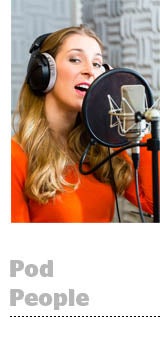 Is dynamic ad insertion finally coming to podcasting?
Is dynamic ad insertion finally coming to podcasting?
New audience measurement guidelines released Thursday by a collection of public radio companies address one of the big concerns advertisers have with the medium – thereby paving the way for new methods of selling and placing ads.
“Up until recently, whenever we put an ad into the show it stayed there. Forever,” said Matt Lieber, president of Gimlet Media, which produces narrative podcasts. He spoke on a New York City panel presented Thursday by WNYC and the Tow Center for Digital Journalism. He noted that Gimlet now works with Megaphone – a tool created by the Slate Group’s audio arm Panoply Media – and the podcast discovery/listening platform Acast to perform dynamic ad insertion.
“You put the ad in and it stays there for a certain amount of time and it comes out when it’s reached a certain amount of impressions,” Lieber said. But Lieber is also hyper-cautious of annoying his audience.
Gimlet traditionally produces ads on behalf of clients. These are read by the podcast host, an approach that doesn’t change even with dynamic ad insertion.
“We’ve been really careful to make sure the listener experience isn’t degraded by that,” he said. “We still produce all of the ads, we are really mindful of where we put the ad break and are mindful that the music fades out and when the ad is done, the music fades back in.”
He added the worst version of dynamic ad insertion would sound like a blaring radio ad. And even with big brand advertisers – he referenced one in the top five in terms of dollars spent – Gimlet produces the ads for them. “Even in dynamic ad insertion, no listener would know we’re using the technology, because it sounds the same as our other ads,” he said.
Sarah van Mosel, chief commercial officer at Acast, said 2016 is the year podcasters will start signing onto platforms that enable dynamic ad insertion en masse.
“It will become the de facto way of doing business,” she said, adding that this will also change the advertising landscape. “There will be a flood of inventory in the space and the rates will plummet.”
This brings a risk of commoditization of ad impressions, and so forward-looking podcasters will figure out what their premium products will be.
Van Mosel pointed to British fashion retailer ASOS, which created a podcast where each episode featured a different young female entrepreneur who’d started a fashion company. Because it was on Acast – a web-based forum – ASOS punctuated the audio with video and click-through ads.
“You could see the shirts these girls designed and buy them from ASOS,” van Mosel said. “You have this multiplatform experience by a brand advertisers, and you’re closing the loop on ecommerce.”
AdExchanger Daily
Get our editors’ roundup delivered to your inbox every weekday.
Daily Roundup
(It’s worth noting that not everyone on the panel was bullish about incorporating video or other visual assets into podcasting. Kerri Hoffman, chief operations officer at the Public Radio Exchange, felt video was competitive to the audio experience, whereas van Mosel felt it could be additive.)
GE offers another high-profile example of brands breaking the traditional barriers of audio advertising via its science fiction podcast “The Message,” launched through Panoply Media.
“GE said they’d keep hands off, so it wouldn’t feel like one big ad,” said Panoply’s chief content officer, Andy Bowers. “And in the end, you didn’t hear any mention of GE until the credits at the end. They wanted to do interesting content and what they got out of it was the association of this popular program.”
Lieber mentioned that GE had also approached Gimlet, and that he had been skeptical. “I didn’t think it would work,” he said. “But it grew real audience – and audience of people who weren’t listening to it as an advertisement or a branded experience.”
He added that GE is a little unique in that it’s a brand more willing to experiment. And he isn’t sure if other advertisers will necessarily follow suit.
“The question is: How much flex will brands have when it comes to doing something interesting versus sending the message?” he wondered.













